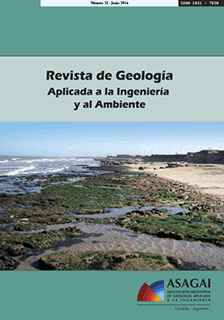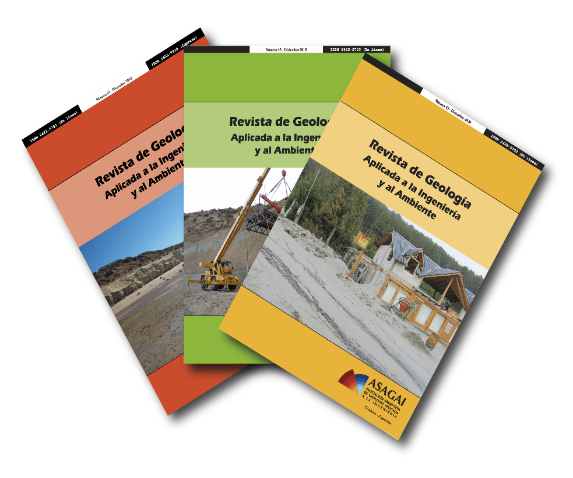Comportamiento de suelos limosos con agregado de fibras sintéticas y cemento
DOI:
https://doi.org/10.59069/mkn22n43Keywords:
cemento, fibra, limo, tensión-deformaciónAbstract
En Córdoba Argentina, las estructuras geotécnicas emplean frecuentemente el suelo limoso bajo condiciones de compactación para el mejoramiento del desempeño de las construcciones. Los mantos superiores correspondientes a limos de origen eólico (loess) se encuentran ampliamente disponibles en sectores de llanuras y áreas cercanas a las sierras de la provincia. La incorporación de materiales minerales o sintéticos, no es una actividad frecuente en la región debido, posiblemente, a la escasez de resultados experimentales que expliquen el desempeño de las mezclas. No se ha encontrado en la literatura estudios locales que estudien materiales compuestos por fibras, aglutinantes y suelo loéssico. Este trabajo presenta un estudio de suelo limoso para el incremento del desempeño de las estructuras geotécnicas por compactación, adición de cemento y fibra sintética. El trabajo experimental incluye ensayos de compresión simple, tracción por compresión diametral y ensayos CBR. Se presenta como se modifica resistencia y rigidez con la incorporación de cemento. Finalmente se muestra como varía el hinchamiento debido a la incorporación de fibras.
References
Arrúa P. y Aiassa G. 2009. Curvas de transferencia de carga horizontal p-y para suelos loéssicos. Revista EIA, Vol. 11, pp. 131-143.
Arrúa P., Aiassa G. and Eberhardt M. 2012. Loess soil stabilized with cement for civil engineering applications. International Journal of Earth Sciences and Engineering. Vol. 05, Nro. 1, pp. 10-18.
Arrúa P., Aiassa G., Eberhardt M. and Alercia Biga C. 2011. Behavior of collapsible loessic soil after interparticle cementation. International Journal of GEOMATE. Vol. 01, Nro. 2, pp. 130-
135.
Bahar R., Benazzoug M., Kenai S. 2004. Performance of compacted cement-stabilised soil. Cement & Concrete Composites 26: 811–820
Clariá J.J. y Vettorelo P.V. 2010. Refuerzo de arenas mediante la adición de fibras sintéticas. XX Congreso Argentino de Mecánica de Suelos e Ingeniería Geotécnica. Mendoza, Argentina.
Consoli N.C., Prietto P.N. and Ulbrich L.A. 1998. Influence of fiber and cement addition on behavior of sandy soil. Journal of Geotechnical and Geoenvironmental Engineering. Vol. 124, Nro. 12, pp. 1211-1214.
Gaynor, R. D.; Meininger, R. C.; and Khan, T. S. 1985. Effects of Temperature and Delivery Time on Concrete Proportions. Temperature Effects on Concrete. STP-858, ASTM, Philadelphia: 68-87.
Goodary R., Lecomte-Nana G.L., Petit C., and Smith D.S. 2012. Investigation of the strength development in cement-stabilized soils of volcanic origin. Construction and Building Materials. Vol. 28, pp. 592-598.
Haofeng Xing, Xiaoming Yang, Chao Xu and Guanbao Ye 2009. Strength characteristics and mechanisms of salt-rich soil–cement. Engineering Geology, 103, p. 33-38.
Hazirbaba K. and Gullu H. (2010). California Bearing Ratio improvement and freeze-thaw performance of fine-grained soils treated with geofiber and synthetic fluid. Cold Regions Science and Technology. Vol. 63, pp. 50-60.
Kumar A., Walia B.S. and Mohan J. 2006. Compressive strength of fiber reinforced highly compressible clay. Construction and Building Materials. Vol. 20, pp. 1063-1068.
Liu J., Wang T. and Tian, Y. 2010. Experimental Study on the Dynamic Properties of Cement- and Lime-Modified Clay Subjected to Freeze-Thaw Cycles. Cold Regions Science and Technology, 61, 1, pp. 29-33.
Millogo Y., Hajjaji M., Ouedraogo R., and Gomina M. 2008. Cement-lateritic gravels mixtures: Microstructure and strength characteristics. Construction and Building Materials. Vol. 22, pp. 2078-2086.
Oyediran I.A. and Kalejaiye M. 2011. Effect of increasing cement content on strength and compaction parameters of some lateritic soils from southwestern Nigeria. The Electronic Journal of Geotechnical Engineering. Vol. 16, pp. 1501-1514.
Plé O. and Lê T.N.H. 2012. Effect of polypropylene fiber-reinforced on the mechanical behavior of silty clay. Geotextiles and Geomembranes. Vol. 32, pp. 111-116.
Raymond N. Yong, Vahid R. Ouhadi, 2007. Experimental study on instability of bases on natural and lime/cement-stabilized clayey soils. Applied Clay Science 35: 238–249
Reginatto A. (1970). Suelos colapsibles. Predicción de la Susceptibilidad al Colapso. 2º Reunión Argentina de Mecánica de Suelos e Ingeniería de Fundaciones. Córdoba, Argentina.
Rocca R., Redolfi E. y Terzariol R. 2006. Características geotécnicas de los loess de argentina. Rev. Int. de Desastres Naturales, Accidentes e Infraestructura Civil. Vol. 6(2) 149-166
Siddique A. and Rajbongshi B. 2002. Mechanical properties of a cement stabilized coastal soil for use in road construction. Journal of Civil Engineering. Vol. 30, Nº1, pp. 51-67.
Tang C., Shi B., Gao W., Chen F., and Cai Y. 2007. Strength and mechanical behavior of short polypropylene fiber reinforced and cement stabilized clayed soil. Geotextiles and Geomembranes. Vol. 25, pp. 194-202.
Yetimoglu T., Inanir M., and Inanir O.E. 2005. A study on bearing capacity of randomly distributed fiber-reinforced sand fill overlying soft clay. Geotextiles and Geomembranes. Vol. 23, pp. 174-183.
Zárate M. 2003. Loess of southern South America. Quaternary Science Reviews, Vol. 22, pp. 1987-2006.
Downloads
Published
Issue
Section
License
Copyright (c) 2014 Journal of Engineering Geology and the Environment

This work is licensed under a Creative Commons Attribution-NonCommercial-ShareAlike 4.0 International License.
Attribution - Non-Commercial - Share Alike (by-nc-sa): No commercial use of the original work or any derivative works is permitted, distribution of which must be under a license equal to that governing the original work.










